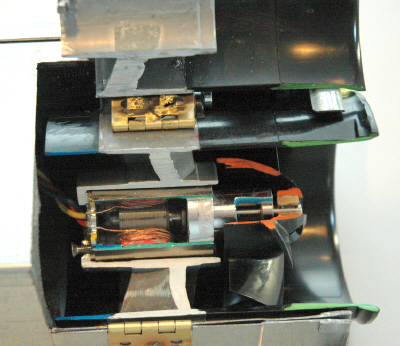HP's super cool computer fans

Inspired by radio controlled model airplanes, HP is developing new fan technologies to cool hardware more efficiently. I talked to Wade Vinson, HP's fan man and thermal technologist, about the new fan technology, which he said will consume about a third of the power of current computer fans.
"We started with an optimum design, whether 1U, blade or 2U, and there was not a fan out there to pull against the impedence we needed," Vinson said. He and a colleague, Ron Noblett, went to a hobby shop in Willis, Texas, 50 miles north of their Houston office, in July 2004, and were "blown away," he said, pun intended. "Over the course of hours, the proprietor brought out blades, fans and boxes, and cranked it up to 40,000 RPM and my life changed that day. The concept of that amount of air coming from that small of a package...I looked at that and didn't see a limit to air cooling." He saw that HP could harness the creativity of hobbyists who are trying to get radio controlled jet to fly 100 miles per hour without gas, combining a ducted fan design with a high-power density brushless motor.

HP's electric-ducted cooling fan prototype
According to Vinson, radio-controlled electric motors in the past 20 years have achieved ten times the density and twice the efficiency of today’s electric fans. He felt that if the radio-controlled motor innovations could be captured in a fan, air-cooling barriers could be broken down and server fans could deliver the cooling capabilities needed by the next generation of blade servers, eventually moving toward a 200-watt motor running at 30,000 RPM.
"We make every gram of airflow count. The way servers are traditionally designed with fans on market, they have a large array of fans and put out a certain volume of air flow and a certain back pressure, and it goes where it can to cool the CPUs. Every fan puts more air through it than is necessary. It's a function of the volume [manufacturing] of fans--it's easy to throw a whole bunch of fans at a certain speed knowing they will be sufficient to cool the chassis. We took a different approach, in which everything we did was to support full featured servers in as small a package as possible. Secondly, knowing how much fan power and air flow was needed, we wanted to deliver a fan with the least power and air flow possible. With these constraints we rethought the problem," Vinson said. "It wasn't rocket science for motor design--it was designing for high volume and low cost."
Officially dubbed the HP Active Cool Fan, the electric-ducted fan debuted in the new BladeSystem servers, shipping in July. HP also formed a thermal team--the Cool Team--including motor designers, bearing experts, aerodynamics experts and acousticians, who have garnered 20 patents associated with the fan, Vinson said. Thirteen of the patents are concerned with the electric-ducted fan internals and seven are related to what you do with the fan once you have it, he added. At this time HP has no plans to license its fan technology.Fan Facts
- At the highest speed, the fan reaches 166 miles per hour.
- The Active Cool Fan design consumes one-third less power and is about half as quiet as traditional server fans.
- It is about 50 percent more efficient in airflow than fans in typical 1u servers.
- Through testing they are designed to be practically fail proof, less than 1% will break down in the next 5 years
- The propeller-like fans were specifically designed to efficiently push air further into the blade chassis without requiring additional power.
- The fans also contain a digital controller so that they can be automated and managed through a network, i.e. spin faster as more server blades or more intensive applications are added.
See also: Wade Roush's story on HP fans in Technology Review